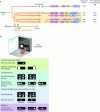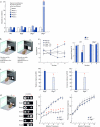Synaptic scaffold evolution generated components of vertebrate cognitive complexity
- PMID: 23201973
- PMCID: PMC4131247
- DOI: 10.1038/nn.3276
Synaptic scaffold evolution generated components of vertebrate cognitive complexity
Abstract
The origins and evolution of higher cognitive functions, including complex forms of learning, attention and executive functions, are unknown. A potential mechanism driving the evolution of vertebrate cognition early in the vertebrate lineage (550 million years ago) was genome duplication and subsequent diversification of postsynaptic genes. Here we report, to our knowledge, the first genetic analysis of a vertebrate gene family in cognitive functions measured using computerized touchscreens. Comparison of mice carrying mutations in each of the four Dlg paralogs showed that simple associative learning required Dlg4, whereas Dlg2 and Dlg3 diversified to have opposing functions in complex cognitive processes. Exploiting the translational utility of touchscreens in humans and mice, testing Dlg2 mutations in both species showed that Dlg2's role in complex learning, cognitive flexibility and attention has been highly conserved over 100 million years. Dlg-family mutations underlie psychiatric disorders, suggesting that genome evolution expanded the complexity of vertebrate cognition at the cost of susceptibility to mental illness.
Figures






Comment in
-
Retooling spare parts: gene duplication and cognition.Nat Neurosci. 2013 Jan;16(1):6-8. doi: 10.1038/nn.3292. Nat Neurosci. 2013. PMID: 23257927 Free PMC article.
References
-
- Gregory RL, editor. The Oxford Companion to the Mind. Oxford University Press; USA: 1987.
-
- Fray PJ, Robbins TW. CANTAB battery: proposed utility in neurotoxicology. Neurotoxicol Teratol. 1996;18:499–504. - PubMed
-
- Barnett JH, et al. Assessing cognitive function in clinical trials of schizophrenia. Neurosci Biobehav Rev. 2010;34:1161–1177. - PubMed
-
- Van de Peer Y, Maere S, Meyer A. The evolutionary significance of ancient genome duplications. Nat Rev Genet. 2009;10:725–732. - PubMed
Publication types
MeSH terms
Substances
Grants and funding
LinkOut - more resources
Full Text Sources
Other Literature Sources
Molecular Biology Databases

